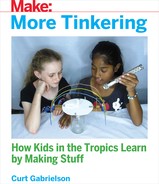Chapter 16
Rock Cycle

Simulate one path in this complex web.
The water cycle is fairly straightforward: evaporation, condensation, and precipitation. Add transpiration—water getting sucked up by plants and going back directly into the air—and a few complexities of groundwater, and that’s the whole thing! The rock cycle is another animal altogether. Not only is it complex with multiple interlinking paths, but it proceeds in such slow motion that we can hardly see anything actually happen in the course of our lifetimes.
That said, it’s pretty important to learn if you’re to understand the vast diversity of rocks you’ll find when you begin observing the ground around you. Each one of them was formed through a certain path within this cycle. This activity will show one path and illuminate the others.
Gather stuff
- Two different-colored candles
- A few crayons of different colors
- Plates
- Matches or a stove
- An aluminum can or two
Gather tools
- Knife or scissors
- Spoon
Tinker
First shave off a little pile of paraffin from both candles.

Then shave off some of the crayons.
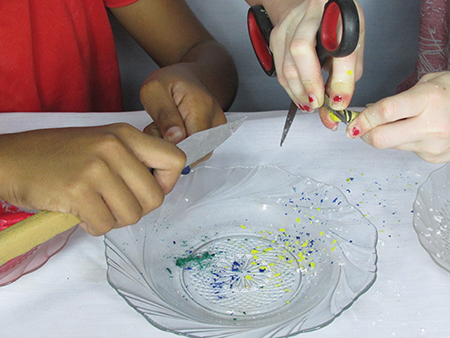
Dump it all together, and then fill up the base divot of an aluminum can.1

Smash the shavings down as firmly as you can with the spoon. Add a bit more and smash it all down again.

Next, carefully dig out a section of it. Try to get a biggish chunk without it falling apart. When you’ve got it, put it gently on a plate. There is your first simulated rock sample.


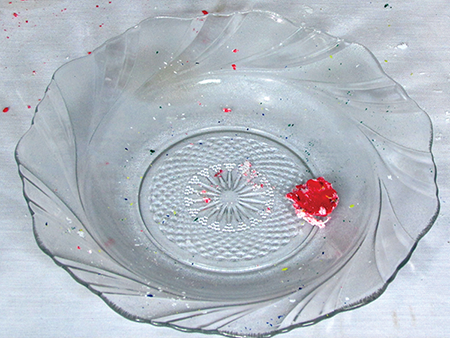
Now prepare a can for heating. It could be the same can, but we used another. Cut it around the base, but leave a little section so that it’s still hooked on.
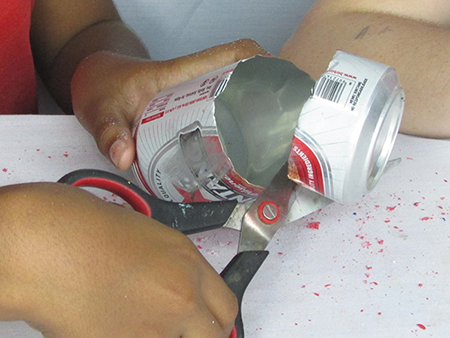
Fill up the divot again with candle and crayon shavings, including the remains of the first operation.

Smash this down as well as you can with the spoon.

Light a candle (on a nonflammable surface) and hold the can bottom full of shavings over the flame for 6 seconds only. You should see the paraffin start to melt around the edges and the bottom.

Take this off and let it cool. You can smash it down a bit more with your spoon after it cools. Again, carefully dig out a section of it and put it on the plate with the other rock sample.

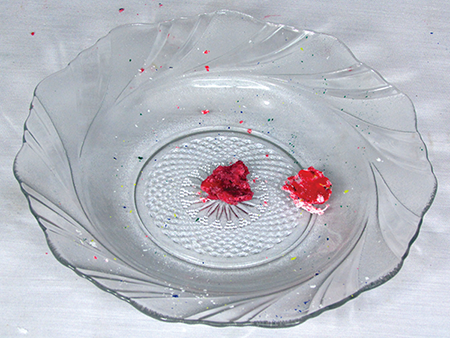
Now put all remaining shavings into that same can bottom, pack it down with the spoon, and heat it again over the candle flame. This time, continue to heat it until it’s all melted to liquid.
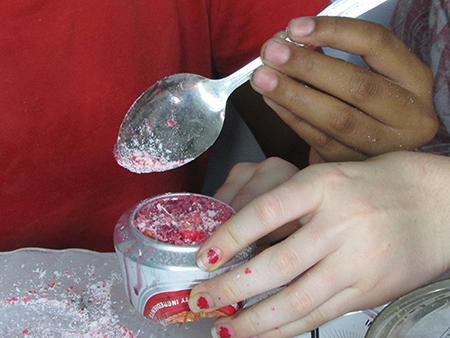

Put it aside and don’t bump it until it’s cool, which could be as long as 5 minutes, even with a fan. Make sure it’s all nice and cool before you dig out the last piece. Put it on the plate with the other two rock samples.

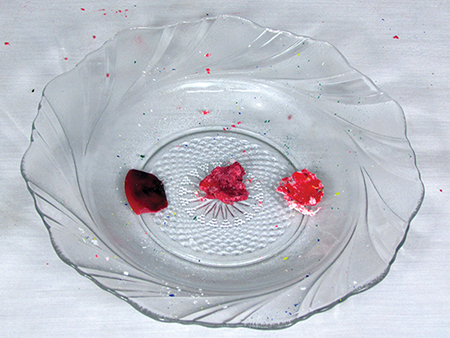
What’s Going On?
What you’ve just witnessed is one path on the rock cycle. Here is a schematic of the whole cycle:
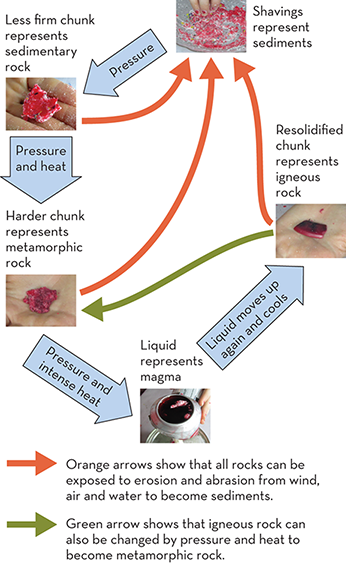
Look at that gaggle of rocks and arrows! First off, let’s name the five stops around the edge. Rocks can be divided into three categories: sedimentary, metamorphic, and igneous. The two other stops are the sediments themselves and molten rock, called magma.
The path you trod was from sediment to sedimentary to metamorphic to magma to igneous. You began by preparing sediments from several minerals: two main minerals—the candles—and other trace minerals—the crayons. Simple pressure on the sediments due to other layers being laid down on top leads to the formation of sedimentary rock. Then if that particular chunk gets pushed farther down, it gets more pressure and a lot of heat and its structure is altered. This is called metamorphic rock. Then if it keeps on going down, it can’t take the heat and it melts into magma. But when magma gets thrust up back into the lithosphere, it cools to become igneous rock again.
One could say you also represented erosion and abrasion with your knife when you shaved the candles and the crayons. This is more or less correct, but since each candle and crayon represents a certain mineral, individually the candles would represent a chunk of that pure mineral, and this just doesn’t occur much. The vast majority of rocks are complex combinations of minerals. When they erode, they end up as a complex sediment.
Notice that not all paths are possible in this cycle and not all arrows go both ways. For example, you don’t get magma straight from sediments. They have to get smashed and mashed deep into the earth to reach the heat necessary to melt them. Also, metamorphic rocks can get busted apart with erosion, but when the sediments come together again, it’s sedimentary, not metamorphic yet.
Of course, this model is a vast generalization. Reality is always more complex. A major sedimentary rock called limestone does not come from erosion at all, but rather millions of years’ worth of dead organisms with shells, big and microscopic, falling and piling up on the floor of a lake or ocean, sometimes on top of a coral reef. And you can find limestone that is harder than some metamorphic rocks. For that matter, the igneous rock pumice, produced as the froth of volcanoes, is so soft you can scratch it with your fingernail.
Still, scientists use models precisely because they are simplified versions of a complex reality, and many parts of this model are right on. Many igneous rocks are more solid than metamorphic ones, many sedimentary rocks are soft to crumbly, and the processes you did to get the model samples are all representative of what happens to real rocks. The model is your friend!
If you’d like to tinker more with this, I suggest going into the nuances of metamorphic rocks. You could prepare different kinds of sediments, some with very little red, some with mostly red, some with a lot of a certain kind of crayon. Then when you smash and heat for 6 seconds, see what you find different and similar between the samples. There are many types of metamorphic rocks, all depending on the composition and the processes that created them. Try to make as many as you can!
